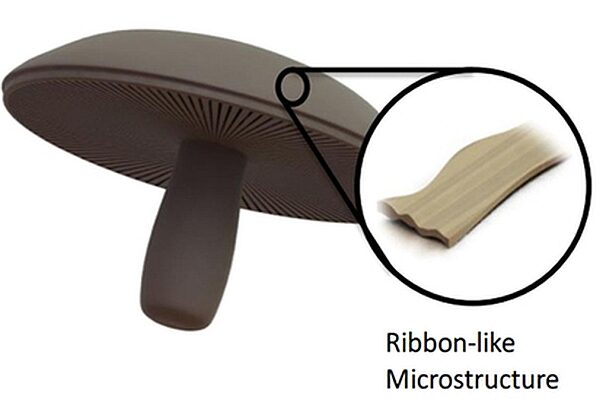
Portobello mushrooms hold the key to improved Li-ion batteries
The researchers created a new type of lithium-ion battery anode using portobello mushrooms, which are inexpensive, environmentally friendly and easy to produce. The current industry standard for rechargeable lithium-ion battery anodes is synthetic graphite, which comes with a high cost of manufacturing because it requires tedious purification and preparation processes that are also harmful to the environment.
With the anticipated increase in batteries needed for electric vehicles and electronics, a cheaper and sustainable source to replace graphite is needed. Using biomass, a biological material from living or recently living organisms, as a replacement for graphite, has drawn recent attention because of its high carbon content, low cost and environmental friendliness.
UC Riverside engineers were drawn to using mushrooms as a form of biomass because past research has established they are highly porous, meaning they have a lot of small spaces for liquid or air to pass through. That porosity is important for batteries because it creates more space for the storage and transfer of energy, a critical component to improving battery performance.
In addition, the high potassium salt concentration in mushrooms allows for increased electrolyte-active material over time by activating more pores, gradually increasing its capacity.
A conventional anode allows lithium to fully access most of the material during the first few cycles and capacity fades from electrode damage occurs from that point on. The mushroom carbon anode technology could, with optimization, replace graphite anodes and also provide a binderless and current-collector free approach to anode fabrication.
"With battery materials like this, future cell phones may see an increase in run time after many uses, rather than a decrease, due to apparent activation of blind pores within the carbon architectures as the cell charges and discharges over time," says Brennan Campbell, a graduate student in the Materials Science and Engineering program at UC Riverside.
Nanocarbon architectures derived from biological materials such as mushrooms can be considered a green and sustainable alternative to graphite-based anodes, says Cengiz Ozkan, a professor of mechanical engineering and materials science and engineering.

Diagram showing how portobello mushrooms are turned into a material for battery anodes.
The nano-ribbon-like architectures transform upon heat treatment into an interconnected porous network architecture which is important for battery electrodes because such architectures possess a very large surface area for the storage of energy, a critical component to improving battery performance.
One of the problems with conventional carbons, such as graphite, is that they are typically prepared with chemicals such as acids and activated by bases that are not environmentally friendly, says Mihri Ozkan, a professor of electrical and computer engineering. The UC Riverside team is focused on naturally-derived carbons, such as the skin of the caps of portobello mushrooms, for making batteries.
Almost 900,000 tons of natural raw graphite would be needed for anode fabrication for nearly six million electric vehicle forecast to be built by 2020 which requires that the graphite be treated with harsh chemicals, including hydrofluoric and sulfuric acids, a process that creates large quantities of hazardous waste. The European Union projects this process will be unsustainable in the future.
For more, see the research findings, outlined in the paper ‘Bio-Derived, Binderless, Hierarchically Porous Carbon Anodes for Li-ion Batteries‘ published in the journal Nature Scientific Reports.
Related articles:
Solid-state Li-ion batteries promise safety, longer life
Reinvented Li-ion cell costs 50% less to produce
Battery technology promises twice the range
 If you enjoyed this article, you will like the following ones: don't miss them by subscribing to :
eeNews on Google News
If you enjoyed this article, you will like the following ones: don't miss them by subscribing to :
eeNews on Google News
